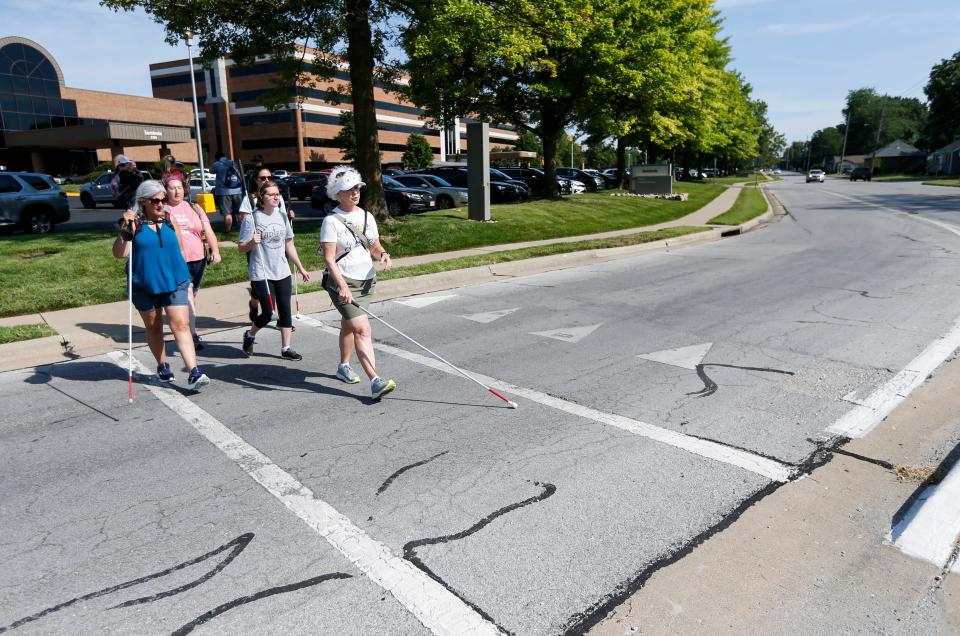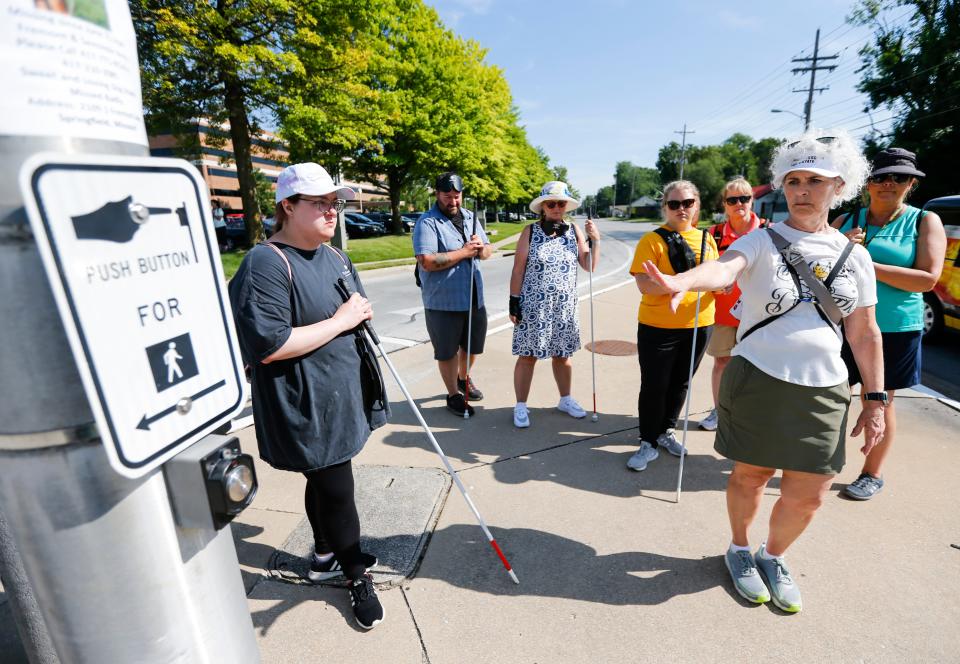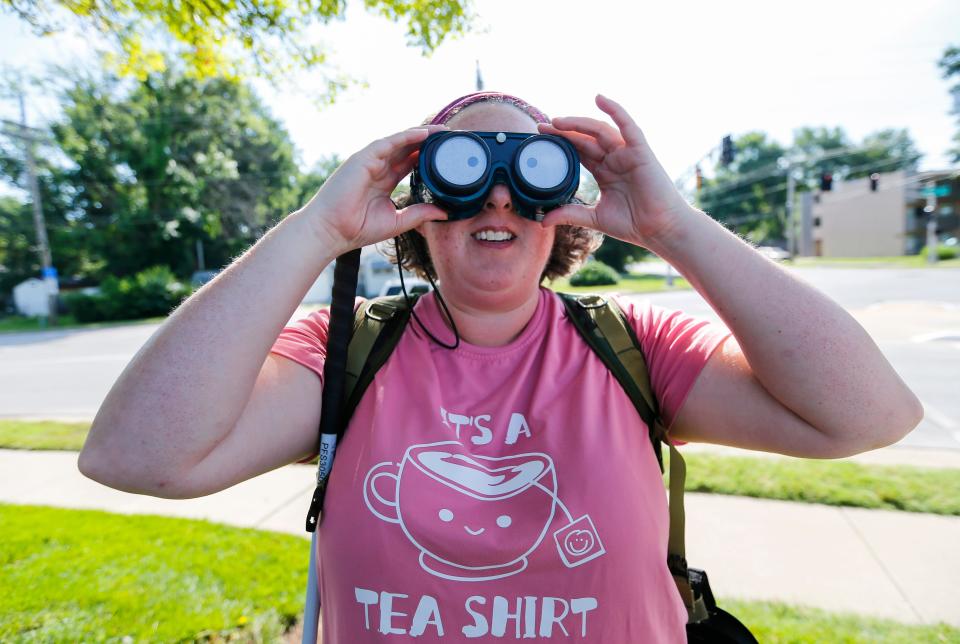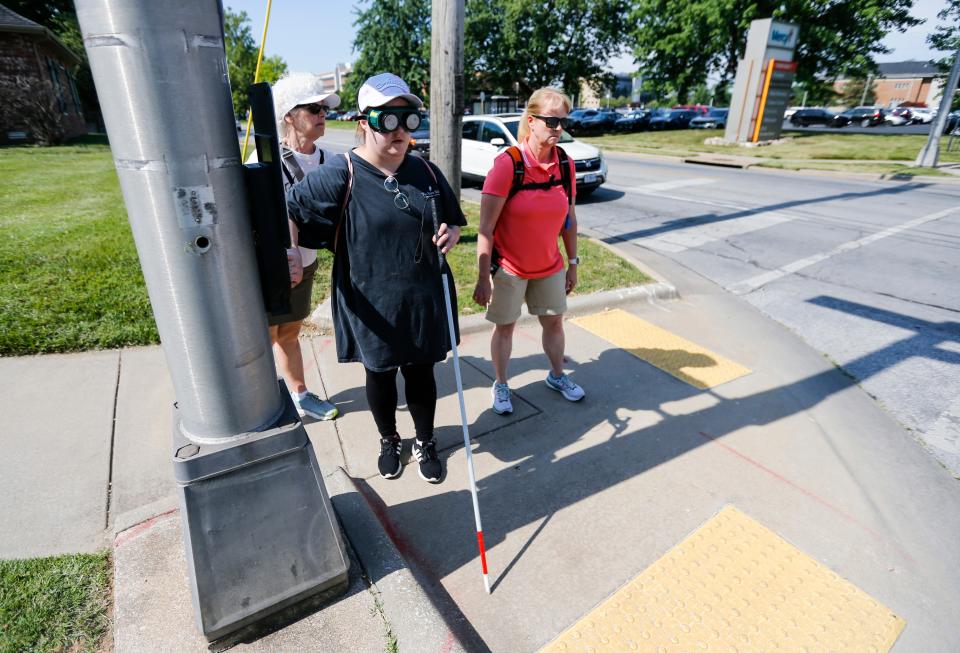During summer, educators learn how to better work with blind, visually-impaired students
Twelve educators from across the Midwest are gathering for six weeks this summer to learn how to better work with students who are blind or visually impaired. Springfield drivers may see these educators walking in pairs with blindfolds, goggles and white canes on crosswalks throughout Center City.
The six-week course is a part of Missouri State University's Orientation and Mobility Graduate Certificate, available for non-degree seeking individuals or as an addition to an existing education with blindness or vision impairment emphasis. This specific summer course, "Instructional Techniques and Strategies of Orientation and Mobility," is six credit hours of the total 18-credit-hour certificate.
While a handful of participants are from Springfield, others traveled out of state for the course, including from Indianapolis and Nashville. Orientation and mobility certification programs are sparse throughout the country, with Missouri State's being the only one in the multi-state region.
Orientation and mobility instruction, or O&M, provides visually- or auditorily-impaired students with skills to understand their environments. Through Missouri State's Orientation and Mobility Graduate Certificate program, participants learn how to better work with these students.
Instructor Reeda Rippee said there is a "huge need" for O&M certified educators following the legislation of HB 1360, which established the Blind Students' Rights to Independence, Training, and Education Act, or BRITE Act. Missouri Gov. Mike Parson signed the bill into law in August 2022.
The BRITE Act requires public school districts to perform orientation and mobility evaluations for blind children by certified instructors. These instructors must hold a valid certification as outlined by the Act, which allows them to teach Braille, accessible assistive technology and orientation and mobility.
During the first week of the course, participants learned how to use blindfolds, low vision simulators and white canes inside Greenwood Laboratory School on Missouri State's campus. Specifically, participants learned the Human Guide Technique, which is used when a blind or visually-impaired individual walks with a guide. They also learned how to navigate classrooms, hallways and bathrooms.
After becoming comfortable indoors, participants moved to working outdoors on Missouri State's campus, before venturing to a residential neighborhood. In their third week, participants are navigating sidewalks and crosswalks in business and commercial areas. The course ends with participants learning how to use public transportation with the blindfolds, low vision simulators and white canes in both Springfield and St. Louis.

In addition to learning how to use the tools and techniques students may use, participants of the course also educate each other. When working in a pair, one participant is "under the blindfold" and the other acts as the instructor. Participants also craft their own lesson plans in the course.
"Instructional Techniques and Strategies of Orientation and Mobility" is taught this year by per course faculty Rippee and JoNita Scarbrough. The course was first offered for a stint of about seven years 10 to 12 years ago, Rippee said. It was resurrected three years ago and Scarbrough has been instructing it since. Rippee joined two years ago and described the course as "very rewarding."

"I tell the students on the first day of class, this is going to be (the most fun) class you've ever had," Rippee said. "When we work with our students, both university students and with our students, we have them kind of out of their comfort zone. We're making them a little bit uncomfortable but that's their zone of learning."
Stacey Buck, a special education teacher at Republic High School, is one of this year's 12 course participants. She said she learned about the program from Scarbrough, who works with her eight-year-old, visually-impaired daughter. Buck said she saw how much a white cane changed her daughter's life, which is why she decided to enroll.

Megan Rogers, a paraprofessional at Springfield Public Schools, said the Orientation and Mobility Graduate Certificate program fell into her lap.
Before the pandemic, Rogers was a high school English teacher, but after struggling to find a job in 2020, she took a position as a paraprofessional.
"I was assigned to a visually-impaired student and I didn't know this area of education existed, so ... I decided I would do by best to research for him," Rogers said. "It was actually his teacher for visual impairment who suggested I join the program because I was going above and beyond my duties to help him."
The course's tuition varies for in-state and out-of-state participants. Per the Missouri State Office of Registrar, the course cost $348 per credit hour for Missouri residents and $694 per credit hour for non-Missouri residents. This results in a total cost of $2,088 for Missouri residents and $4,164 for non-Missouri residents.

In addition to the hands-on summer course, to receive the Orientation and Mobility Graduate Certificate, participants must complete the following courses:
"Principles of Orientation and Mobility": Focus on history, philosophy and ethics or orientation and mobility
"Low Vision Anatomy and Physiology of the Eye": Focus on eye diseases and conditions which may cause impairment, along with hands-on use of low vision simulators and low vision examinations
"Professional Issues Related to Orientation and Mobility with Diverse Populations": Focus on ethics and certification standards, in addition to literature pertinent to the profession
"Health, Functional and Psychological Aspects of Disabilities": Interdisciplinary focus on a range of disabilities
Lastly, participants must complete a 350-hour internship with an organization or school that serves blind or visually-impaired individuals.
More information about Missouri State's Orientation and Mobility Graduate Certificate is available online at bit.ly/3XBJUz1.
This article originally appeared on Springfield News-Leader: Schools face 'huge need' for orientation, mobility certified educators

